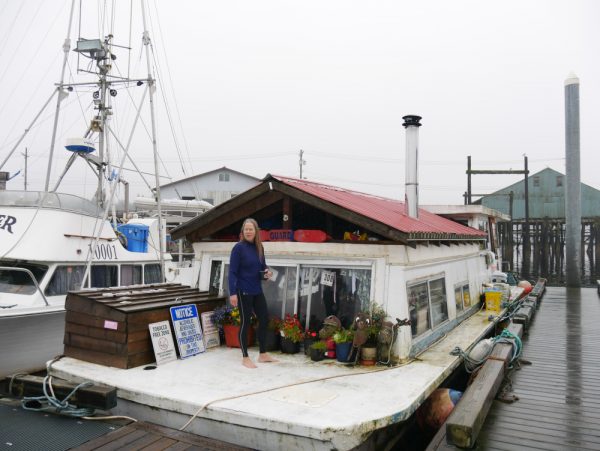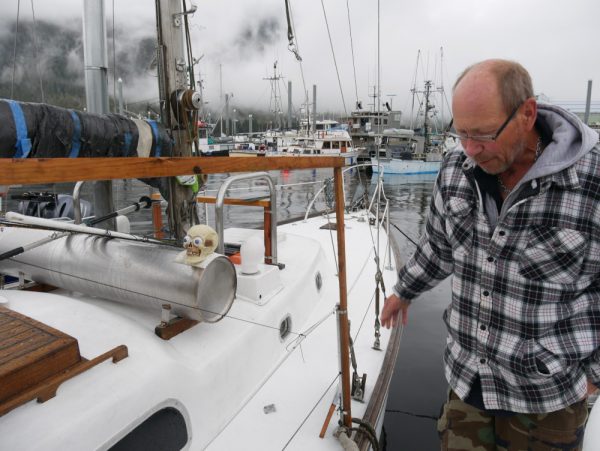
Down in what most people know as Petersburg’s North Harbor, Pamela Speck, who’s watering her plants outside her houseboat, says she has another name for it.
“I jokingly call it, especially at a really low tide, this is lower Petersburg,” she said. “When you get to the top of the ramp, then you’re in upper Petersburg.”
Speck’s home is actually more house than boat — it’s got a pitched tin roof, windows instead of portholes, and of course the flower pots on the stern deck, which is now essentially a porch. She bought the boat in 1993 while working at one of the canneries. She ended up staying, mainly because it was so cheap compared to shoreside housing.
“People think it’s hard now. But back then, you know might have gotten an apartment besides Kito’s which was a dump — not saying they’re dumps now — for a $1,000 a month or 800 bucks a month. And so it was just an exorbitant price,” she said.
Exorbitant to her but not uncommon. A one-bedroom in Petersburg in “rough shape” can fetch around $850, according to Peterbsurg’s 2016 Comprehensive Plan. The plan also found that 36% of renter households were not living in affordable housing.
Throughout Southeast Alaska, many people make their home on boats. So-called “liveaboards” are motivated by a variety of factors — lack of affordable housing, a sense of adventure or those who already work on the water. It’s not always an easy life. Liveaboards are a longstanding part of the Petersburg community.
Speck came to Alaska via Ohio. And says she didn’t expect to stay very long, much less spend more than a quarter century in a floating house. But she says this lifestyle grew on her, for a lot of reasons.
“You know it allowed me to pay my student loans off ten years early,” Speck said. “It allowed me to save money and do investing. It allowed me to also be able to buy some property in Belize and build a house down there.”
Of course, living on a boat isn’t free. She pays for utilities and moorage fees, plus a $60-a-month liveaboard fee charged by the harbor master’s office. But it’s still cheaper than most rentals in town.
And with the savings, she can spend the cold weather months in Central America. But that makes her an outlier. Petersburg harbor master Glorianne Wollen says the dock’s liveaboard community actually grows in the winter.
“We have a few less in the summertime, we rent about 20, maybe 22,” Wollen said. “And then it bumps up to maybe 30, 35 in the winter.”
Her office tracks liveaboards and she’s not keen to see their numbers grow. That’s so there’s enough room for commercial vessels and boats passing through. On the other hand, she says it’s nice to have a stable community down on the docks.
“You know liveaboards are appreciated by many of the longterm stall holders because they kinda keep an extra eye on things,” she said. “So there’s a pretty good relationship between liveaboards and the entire community down here in the harbor.”

One of the people keeping an eye on things is Frankie Christensen. He lives year-round on his 34-foot sailboat a few stalls down from Speck. He’s a boat mechanic and has been living in North Harbor for the last three years. He was attracted to the freedom of life on the water, the affordability doesn’t hurt either.
“Well, I’ll put it do you this way,” he said. “What a lot of people pay in one month, I pay for a year.”
The cabin is compact but spacious for a boat of its size, and the high ceiling allows you to stand comfortably. A big diesel-powered stove sits in the corner, keeping the place warm. Christensen says North Harbor is a neighborhood.
“It’s a small little community, everybody shares everything. We’re always swapping food,” he said. “And I have a lot of boat captains that drop off fish and crab. It’s a very giving community.”
As if on cue, Pamela Speck walks past and tells Christensen she’ll take his trash up to the dumpster. She’s headed up anyway.
“Ok Pamela, thank you!” he called up to her. “See?” he said, turning back to me. “People are nice. She’s walking by and taking my garbage for me.”
Both Speck and Christensen say they plan to eventually settle on dry land. Christensen says he’d like to build a little cabin. Speck wants to live in Belize full time where she spends most winters. But given Petersburg’s tight housing market, it’s possible that others could soon take their place.
This report is part of CoastAlaska’s Shelter series which examines short- and long-term housing issues across Southeast Alaska.




